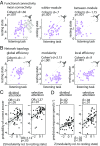Modular reconfiguration of an auditory control brain network supports adaptive listening behavior
- PMID: 30587584
- PMCID: PMC6329957
- DOI: 10.1073/pnas.1815321116
Modular reconfiguration of an auditory control brain network supports adaptive listening behavior
Abstract
Speech comprehension in noisy, multitalker situations poses a challenge. Successful behavioral adaptation to a listening challenge often requires stronger engagement of auditory spatial attention and context-dependent semantic predictions. Human listeners differ substantially in the degree to which they adapt behaviorally and can listen successfully under such circumstances. How cortical networks embody this adaptation, particularly at the individual level, is currently unknown. We here explain this adaptation from reconfiguration of brain networks for a challenging listening task (i.e., a linguistic variant of the Posner paradigm with concurrent speech) in an age-varying sample of n = 49 healthy adults undergoing resting-state and task fMRI. We here provide evidence for the hypothesis that more successful listeners exhibit stronger task-specific reconfiguration (hence, better adaptation) of brain networks. From rest to task, brain networks become reconfigured toward more localized cortical processing characterized by higher topological segregation. This reconfiguration is dominated by the functional division of an auditory and a cingulo-opercular module and the emergence of a conjoined auditory and ventral attention module along bilateral middle and posterior temporal cortices. Supporting our hypothesis, the degree to which modularity of this frontotemporal auditory control network is increased relative to resting state predicts individuals' listening success in states of divided and selective attention. Our findings elucidate how fine-tuned cortical communication dynamics shape selection and comprehension of speech. Our results highlight modularity of the auditory control network as a key organizational principle in cortical implementation of auditory spatial attention in challenging listening situations.
Keywords: auditory cortex; cingulo-opercular network; functional connectome modularity; semantic prediction; spatial attention.
Copyright © 2019 the Author(s). Published by PNAS.
Conflict of interest statement
The authors declare no conflict of interest.
Figures






References
-
- Davis MH, Ford MA, Kherif F, Johnsrude IS. Does semantic context benefit speech understanding through “top-down” processes? Evidence from time-resolved sparse fMRI. J Cogn Neurosci. 2011;23:3914–3932. - PubMed
-
- Colflesh GJ, Conway AR. Individual differences in working memory capacity and divided attention in dichotic listening. Psychon Bull Rev. 2007;14:699–703. - PubMed
Publication types
MeSH terms
Grants and funding
LinkOut - more resources
Full Text Sources

